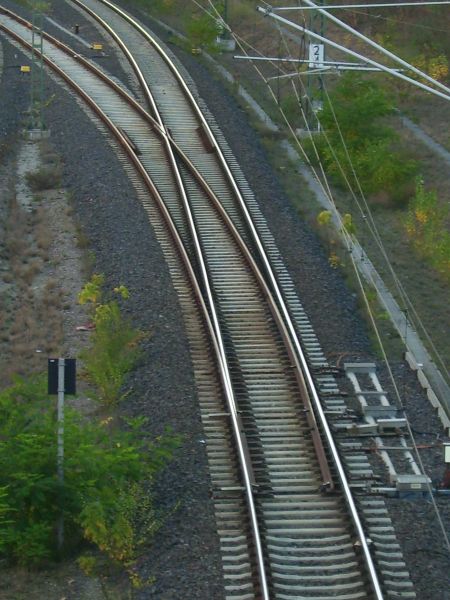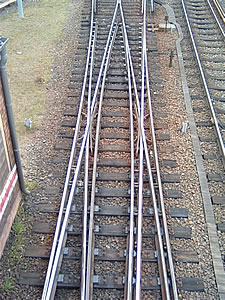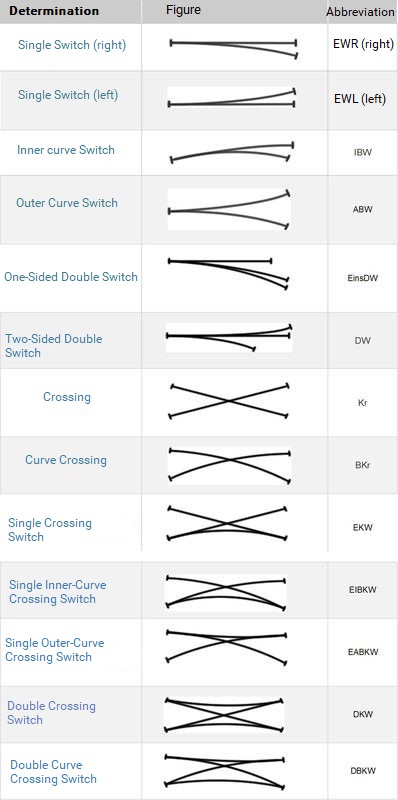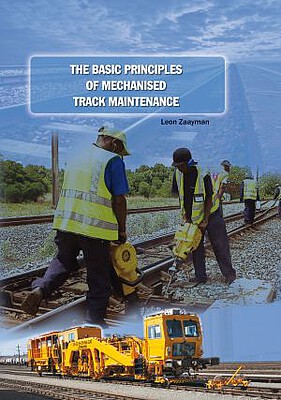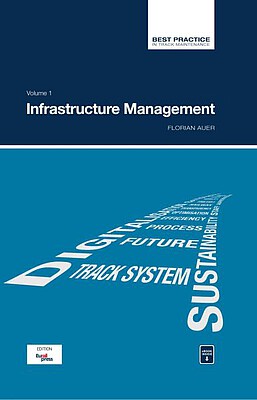Types of turnouts
Single turnouts
Simple turnouts consist of a straight main track and a curved branch track. Looking toward the end of the turnout, a distinction is made depending on the direction of the junction between simple turnout left and simple turnout right. If the radius of the diverging line ends in front of the crossing, it is referred to as a turnout with a straight crossing. Simple turnouts generally have no superelevation.
Curved turnouts
Curved turnouts can be divided with regard to the direction of the diverging line into outer curved turnouts and inner curved turnouts.
If the deviating line goes in the direction of the middle point of the track curve of the main line, it is called an inner curve turnout. In other words, in an inner curve turnout the centre point of the track curve of the main line and that of the diverging line lie on the same side. In spite of the position of curved turnouts in the curve the angle of the turnout and the length of the tangents do not change. The inclination of the original form remains the same. The necessary change in length of the rail is done by adjustment of the closure rail. The entire turnout is rotated around the middle point of the turnout (point of intersection of the tangents). In general, either the curve with the larger load or with the larger radius is designated as the main line.
The crossing of curve turnouts can lie in the turnout outer rail of the main line. In combination with the prevailing partially uncompensated accelerations, the check rails and the wheels of the vehicles are subject to heavy loading. Curved turnouts cause particularly high maintenance costs and should, if possible, be avoided.
In outer curved turnouts which are placed in a curve with superelevation, it is inevitable that there will be negative camber in one rail. This must be taken into account when specifying the speed through the turnout. Symmetrical outer curved turnouts are turnouts whose branching rail and main rail have the same but opposite curvature.
Crossing
If a meeting of two tracks on the same level cannot be avoided and a change between the tracks is not desired, then crossing elements should be created. These enable the intersection of several tracks without changing direction. In the context of crossings four rails meet which places special challenges on the track guiding. Simple crossings, as are already known from the turnout, guarantee safe wheelset guidance in the acute-angled section. A double crossing with bent out check rails is arranged in the area of the obtuse-angled meeting of the two lines of rails. Regular crossings have a slope of 1:9[1] and are no longer fitted without swing nose crossings in tracks with a maximum speed of over 100 km/h[2]. Crossings with a flatter angle than 1:9 are constructed with swing nose crossings. The special bent form of the check rails does not allow the wheel to be guided on the entire length of the crossing. For part of it the wheelset stays in the specified track solely on the basis of inertia and friction[2].
With a smaller angle of inclination, the derailment safety would no longer be given by the gaps in the track guidance. Crossings are curved in a similar way to turnouts, in order to be able to use them in curves. The same criteria applies in this process as when turnouts are customized to the curvature of a curve. The crossing is curved at the intersection centre point while maintaining the main dimension. Both rails have the same radius after bending. The change of length is compensated by the harmonisation of the closure rails. Regular crossings (regular inclination 1:9) can be bent to a radius r = 450 m. Special crossings allow radii r < 1,000 m[1]. A further reduction of the curvature r < 750 m is only permitted with an additional arrangement of check rails or the extension of the existing ones.
Diamond crossing with slips
The combination between crossing and turnout is designated as a double diamond with slips. A distinction is made between single crossings with slips (EKW – einfache Kreuzungsweichen) and double crossings with slips. EKW enable the running over the crossing as well as the simple change to the diverging track. If this change is possible in both diverging directions, one speaks of a double diamond crossing with slips. The basis for crossings with slips is the regular crossing with a slope of 1:9. Depending on the type of crossing with slips (single or double) two or four turnouts are arranged. The use of the regular crossing allows the use of two different branch track radii. Depending on this the tongue devices lie outside (r = 500 m) or inside (r = 190 m) the crossing square. This is a result of the four crossings and the intermediate straight pieces of rail. Even if it is possible to bend crossings with slips up to a radius of r = 450 m[3] this should not be done. The complex components are expensive to maintain and are, therefore, to be avoided in new buildings.
You can find suitable specialist literature about the topic here:
The Basic Principles of Mechanised Track Maintenance
This book is dedicated to the many people involved in the day to day planning and performance of track maintenance activities. Providing a practical approach to everyday challenges in mechanised track maintenance, it is not just intended as a theoretical approach to the track system.
Railways aim at transporting people and freight safely, rapidly, regularly, comfortably and on time from one place to another. This book is directed to track infrastructure departments contributing to the above objective by ensuring the track infrastructure’s reliability, availability, maintainability and safety – denoted by the acronym RAMS. Regular, effective and affordable track maintenance enable RAMS to be achieved.
Best Practice in Track Maintenance, Vol 1 - Infrastructure Management
Infrastructure Management Volume 1 looks at aspects of infrastructure management with particular reference to the single European railway area. Based on best-practice examples from Central Europe, measures for the targeted retrofitting and improvement of the infrastructure maintenance of the existing network are presented. In many cases, infrastructure operators are faced with a generational change, which accelerates the process. Modern information and communication technology can simplify the comprehension and presentation of complex contexts. Modified approaches to asset management and life-cycle management enable implementation of the "transparent permanent way" or the "railway 4.0".

